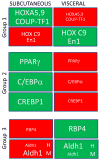The contribution of vitamin A to autocrine regulation of fat depots
- PMID: 21704731
- PMCID: PMC3196743
- DOI: 10.1016/j.bbalip.2011.06.004
The contribution of vitamin A to autocrine regulation of fat depots
Abstract
Morbidity and mortality associated with increased white fat accumulation in visceral fat depots have focused attention on the pathways regulating the development of this tissue during embryogenesis, in adulthood, and while under the influence of obesogenic diets. Adipocytes undergo clonal expansion, differentiation (adipogenesis) and maturation through a complex network of transcriptional factors, most of which are expressed at similar levels in visceral and subcutaneous fat. Rigorous research attempts to unfold the pathways regulating expression and activity of adipogenic transcription factors that act in a fat-depot-specific manner. Peroxisome proliferator-activated receptor-γ (PPARγ) is the master regulator of adipogenesis, and is expressed at higher levels in subcutaneous than in visceral depots. PPARγ expression in adipogenesis is mediated by CCAAT/enhancer binding proteins (C/EBPs) and several transcription factors acting in conjunction with C/EBPs, although alternative pathways through zinc-finger protein-423 (ZFP423) transcription factor are sufficient to induce PPARγ expression and adipogenesis. Vitamin A and its metabolites, retinaldehyde and retinoic acid, are transcriptionally-active molecules. Retinoic acid is generated from retinaldehyde in adipose tissue by the aldehyde dehydrogenase-1 family of enzymes (Aldh1). In this review, we discuss the role of Aldh1 enzymes in the generation of retinoic acid during adipogenesis, in the regulation of the transcriptional network of PPARγ in a fat-depot-specific manner, and the important contribution of this autocrine pathway in the development of visceral obesity. This article is part of a Special Issue entitled Retinoid and Lipid Metabolism.
Published by Elsevier B.V.
Figures




Similar articles
-
Concerted action of aldehyde dehydrogenases influences depot-specific fat formation.Mol Endocrinol. 2011 May;25(5):799-809. doi: 10.1210/me.2010-0465. Epub 2011 Mar 24. Mol Endocrinol. 2011. PMID: 21436255 Free PMC article.
-
MiR-27 orchestrates the transcriptional regulation of brown adipogenesis.Metabolism. 2014 Feb;63(2):272-82. doi: 10.1016/j.metabol.2013.10.004. Epub 2013 Oct 24. Metabolism. 2014. PMID: 24238035
-
Fenretinide treatment prevents diet-induced obesity in association with major alterations in retinoid homeostatic gene expression in adipose, liver, and hypothalamus.Diabetes. 2013 Mar;62(3):825-36. doi: 10.2337/db12-0458. Epub 2012 Nov 27. Diabetes. 2013. PMID: 23193184 Free PMC article.
-
Molecular Regulation of Adipogenesis and Potential Anti-Adipogenic Bioactive Molecules.Int J Mol Sci. 2016 Jan 19;17(1):124. doi: 10.3390/ijms17010124. Int J Mol Sci. 2016. PMID: 26797605 Free PMC article. Review.
-
Aldehyde dehydrogenase 1A1: friend or foe to female metabolism?Nutrients. 2014 Mar 3;6(3):950-73. doi: 10.3390/nu6030950. Nutrients. 2014. PMID: 24594504 Free PMC article. Review.
Cited by
-
Relationship between the Nutritional Status of Vitamin A per Trimester of Pregnancy with Maternal Anthropometry and Anemia after Roux-en-Y Gastric Bypass.Nutrients. 2017 Sep 8;9(9):989. doi: 10.3390/nu9090989. Nutrients. 2017. PMID: 28885564 Free PMC article.
-
Roux-en-Y Gastric Bypass Aggravates Vitamin A Deficiency in the Mother-Child Group.Obes Surg. 2018 Jan;28(1):114-121. doi: 10.1007/s11695-017-2791-6. Obes Surg. 2018. PMID: 28676956
-
Roles of Vitamin A Metabolism in the Development of Hepatic Insulin Resistance.ISRN Hepatol. 2013 Sep 30;2013:534972. doi: 10.1155/2013/534972. eCollection 2013. ISRN Hepatol. 2013. PMID: 27335827 Free PMC article. Review.
-
Encapsulation Thermogenic Preadipocytes for Transplantation into Adipose Tissue Depots.J Vis Exp. 2015 Jun 2;(100):e52806. doi: 10.3791/52806. J Vis Exp. 2015. PMID: 26066392 Free PMC article.
-
ALDH1A1 Inhibits Chicken Preadipocytes' Proliferation and Differentiation via the PPARγ Pathway In Vitro and In Vivo.Int J Mol Sci. 2020 Apr 29;21(9):3150. doi: 10.3390/ijms21093150. Int J Mol Sci. 2020. PMID: 32365706 Free PMC article.
References
-
- Deitel M. Overweight and obesity worldwide now estimated to involve 1.7 billion people. Obes Surg. 2003;13:329–330. - PubMed
-
- Li C, Ford ES, McGuire LC, Mokdad AH. Increasing trends in waist circumference and abdominal obesity among US adults. Obesity (Silver Spring) 2007;15:216–224. - PubMed
-
- Zhang C, Rexrode KM, van Dam RM, Li TY, Hu FB. Abdominal obesity and the risk of all-cause, cardiovascular, and cancer mortality: sixteen years of follow-up in US women. Circulation. 2008;117:1658–1667. - PubMed
-
- Reis JP, Macera CA, Araneta MR, Lindsay SP, Marshall SJ, Wingard DL. Comparison of overall obesity and body fat distribution in predicting risk of mortality. Obesity (Silver Spring) 2009;17:1232–1239. - PubMed
-
- Chan JM, Rimm EB, Colditz GA, Stampfer MJ, Willett WC. Obesity, fat distribution, and weight gain as risk factors for clinical diabetes in men. Diabetes Care. 1994;17:961–969. - PubMed
Publication types
MeSH terms
Substances
Grants and funding
LinkOut - more resources
Full Text Sources
Miscellaneous

